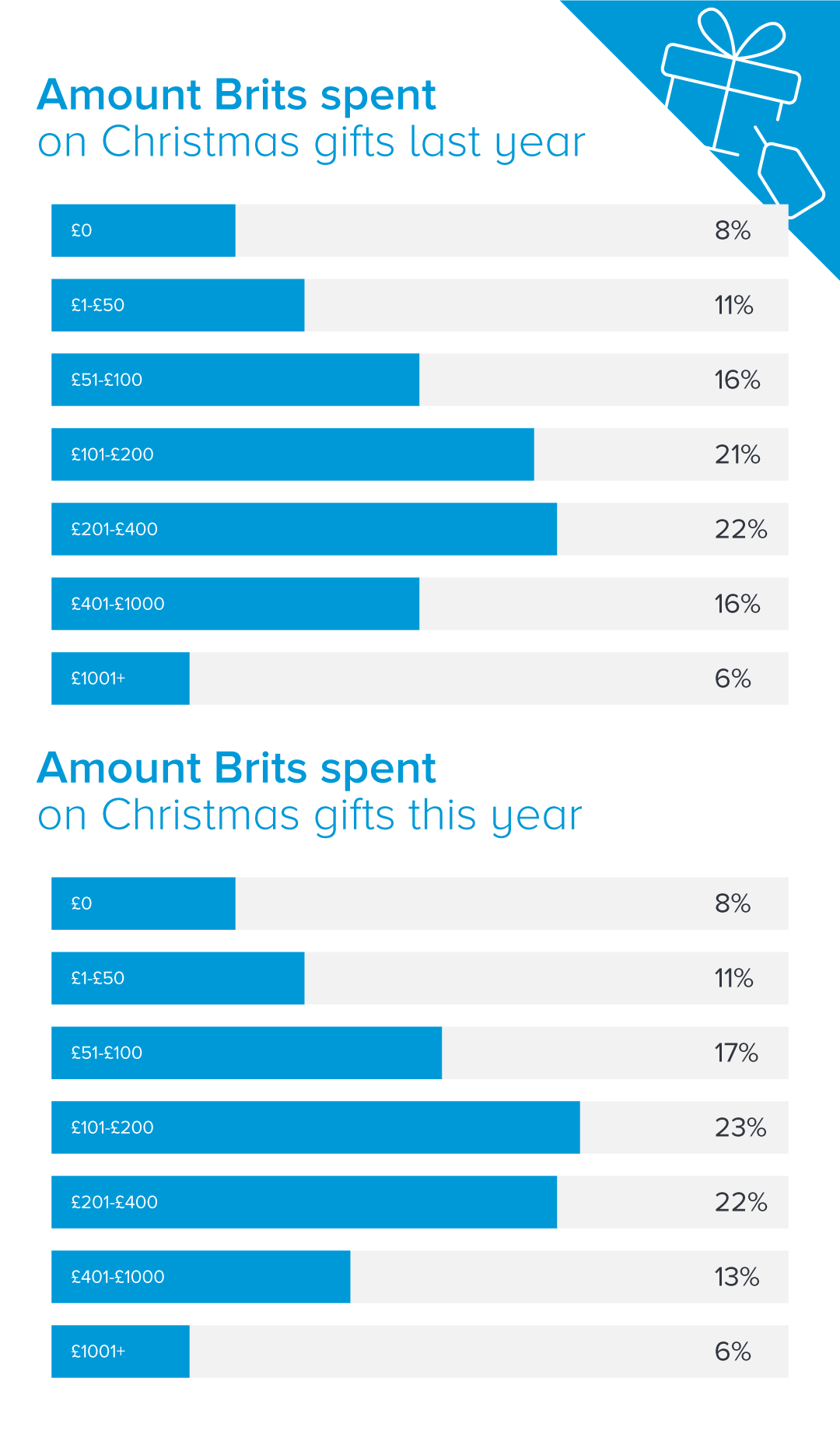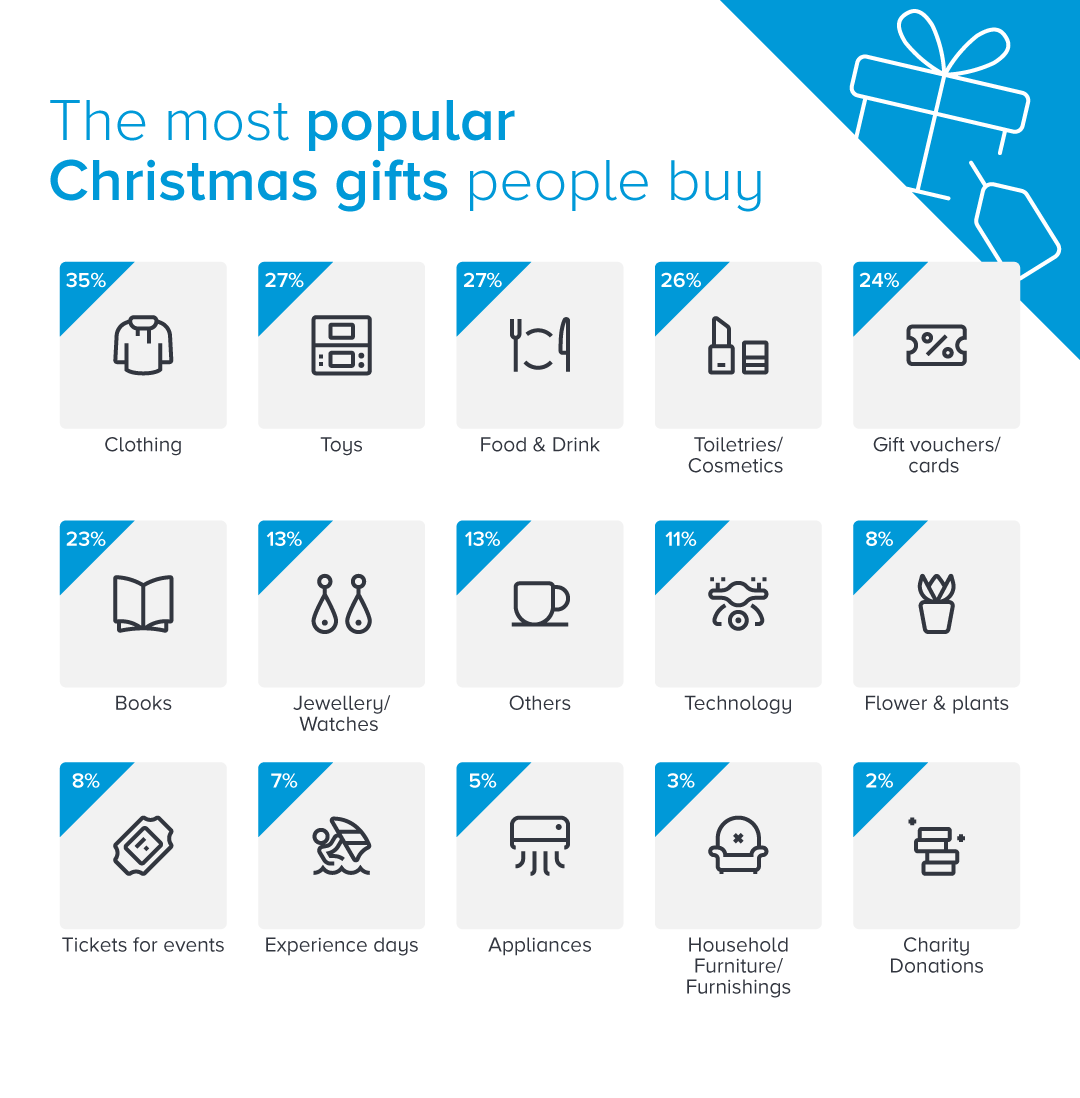
Christmas is fast approaching, which means that brands and organisations across the country are putting together their festive advertising strategies.
With that in mind, we’ve dived deep into our data and pulled out some revelatory insights regarding the who, what, where, when, why and how (much) of Christmas gifting in the UK.
The Clear Channel ‘Gifting in the UK’ report can help businesses target their efforts more effectively as they start their holiday season marketing pushes. From the most purchased gifts in each city to the percentage of online-only shoppers, here’s how Brits approach Christmas gifting.
The most generous cities in the UK
Some people live for the run-up to Christmas and love nothing more than picking out gifts for everyone they know. Others find the whole gift buying thing, well, a bit of a chore.
We took a look at which cities most enjoy giving gifts, to see if there’s any correlation between different areas and a propensity towards generosity at Christmas:

As it turns out, holding a preference for gift-giving doesn’t have much to do with whether you’re from the North, South, or anywhere else. While Liverpool claims the top spot, doing the North West proud, the rest of the top 5 is made up of cities from the South East, Midlands, North East and South West.
It’s not all about England, though. Scotland also claims a place in the top 10, with 53% of respondents in Edinburgh saying they like to give presents. Wales just makes it into the top 15 with Cardiff, where 45% of people are happy gift-givers.
How much people are spending on Christmas gifts in the UK
One of the biggest questions surrounding Christmas gift-giving is how much you should be spending on presents. For lots of people, the pressures of social media can lead to a belief that everyone except you is spending thousands - but is that really the case?
To find out, we gathered data on how much Brits plan to spend on Christmas gifts in 2023 and compared it to the amount they actually spent last year.

Well, as it turns out, the answer to whether everybody is spending thousands is a firm ‘no’. In fact, only 6% of people plan to spend over £1000 this Christmas - the exact same percentage as last year.
The same consistency is just as evident amongst lower spenders. 11% of people have budgeted £50 or less for Christmas gifts, while 8% of people plan to spend nothing at all, replicating the figures from 2022.
Although there’s a remarkable similarity between the two data sets, it should be noted that the only real change comes from the £401-£1000 bracket. This is the amount 13% of people plan to spend this year, compared to 16% last year.
That difference is made up by mid-range spenders - 23% have budgeted £101-£200 for Christmas gifts in 2023, up from 21% in 2022. The amount of people planning on spending £51-£100 has also risen from 16% last year to 17% this year.
With all this in mind, brands should feel reassured that their pricing strategies won’t need to differ too much from last year. However, as there has been a slight dip in the number of people looking to spend larger amounts, there’s an opportunity to drive sales with price-led creatives.
The most popular ways to shop for gifts
Online shopping has been growing in popularity over the last couple of decades. Following the COVID-19 pandemic, when the online world became even more integrated into daily life, there was even speculation that this would be it for the high-street.
But our survey data proves this is far from being the case. We asked 1,000 respondents how they prefer to do their Christmas shopping, and these were the results: That’s right – only 25% of people plan to do all of their Christmas shopping online, while 34% will be looking to the high-street for inspiration. More interestingly, the majority (41%) prefer to use a mixture of online and in-store shopping.
That’s right – only 25% of people plan to do all of their Christmas shopping online, while 34% will be looking to the high-street for inspiration. More interestingly, the majority (41%) prefer to use a mixture of online and in-store shopping.
Aside from proving what we already all know to be true (that the last-minute Christmas Eve rush to buy presents isn’t going anywhere), this data also demonstrates the importance of Out of Home (OOH) advertising in the run-up to Christmas.
By using outdoor displays to advertise in retail environments, brands can put themselves in front of audiences who are actively looking to purchase. On top of this, mobile searches done out of home are 38% more likely to lead to a purchase. This makes OOH a powerful way to drive sales both online and offline.
Our previous research has shown that consumers start shopping early, so brands should take heed and start planning their strategies now.
The most popular Christmas gifts people buy
Actually going out and purchasing gifts is only half the battle for most people – deciding what to buy takes far more time and effort. For brands, this presents a big opportunity to not just influence buyers, but also remove the stress from their decision-making.
To do this effectively, understanding different demographics’ purchasing preferences is key. So, we trawled through the data from last year to find out which gifts are most popular with buyers:
 In the battle of socks and smellies, socks come out on top, as 35% of respondents reported buying clothing compared to 26% having purchased toiletries. Toys were, unsurprisingly, another popular choice, with 27% having bought one as a gift.
In the battle of socks and smellies, socks come out on top, as 35% of respondents reported buying clothing compared to 26% having purchased toiletries. Toys were, unsurprisingly, another popular choice, with 27% having bought one as a gift.
The most purchased gifts by gender
We also looked at how men and women’s gift purchases varied.
 Clothing remained the most popular choice among each of the two genders surveyed. However, while women were more likely to buy gifts in the form of toiletries or cosmetics, men tended to lean more heavily towards food and drink.
Clothing remained the most popular choice among each of the two genders surveyed. However, while women were more likely to buy gifts in the form of toiletries or cosmetics, men tended to lean more heavily towards food and drink.
Men also clearly felt more comfortable letting their giftees choose for themselves, as gift cards were the fourth most popular purchase. Women, on the other hand, preferred the more traditional option of giving books.
The most purchased gifts in each city
A location-based approach is one of the easiest ways to increase outdoor advertising’s effectiveness. At Christmastime, this could mean targeting local audiences with tailored creatives that reflect their gift-purchasing preferences.
To allow advertisers to do just that, we’ve broken down the most purchased gifts by UK city.

We might be a more united nation than we think, at least when it comes to a penchant for fashion. Clothing gifts were the most commonly purchased in almost every city, with only Nottingham bucking the trend.
Instead, Nottingham locals bought more books than any other category (35%), with clothing gifts (34%) being demoted to third place, behind toys (29%).
Gift cards and vouchers were popular in London (21%), Birmingham (23%) and Sheffield (22%). But Southampton trumped all other areas in this regard - 36% of people decided to let their giftees choose for themselves.
And if it were ever in any doubt, our findings also confirm that we’re still a nation of food and drink lovers. Gifts in this category appeared in the top three most purchased for many cities across the UK, but they were most popular in Cardiff (37%), Liverpool (36%) and Brighton and Hove (34%).
Insights like these help brands to be strategic when designing their Christmas advertising strategies. By taking a more targeted approach, they can ensure that their creatives resonate with audiences and spur action.
The people who gift-givers spend the most time and effort on
The final area of our Gifting in the UK Report looks at whose gifts people put the most time and effort into:
 One of the five love languages is receiving gifts, which might explain why 63% of people pay close attention when choosing a present for their partner.
One of the five love languages is receiving gifts, which might explain why 63% of people pay close attention when choosing a present for their partner.
Family dominates friends when it comes to thoughtful gifts – 56% put extra effort into picking out gifts for their wider family, compared to 47% of friends. It’s bad news for grandparents, though – only 15% of people put their energy into gifts for Nan and Grandad.
The best spots for Christmas advertising
As the holiday season draws closer, both national and local-level brands are gearing up for the surge in shoppers on the hunt for gifts. Competition among retailers is high, and strategic advertising is required to stand out from the crowd.
As one of the UK’s leading Out of Home media owners, we’ve seen enough Christmas campaigns to know what works and what doesn’t. Choosing the right environment is the first step, with shopping centres and high-street advertising placing brands right in the midst of the action.
In the weeks and months leading up to Christmas, brands can deliver broadcast reach messaging to build awareness, recall and consideration. OOH marketing boosts online engagement more than other media, at only a fraction of the cost, so this is the ideal time to amplify activity across channels.
As the big day itself heads closer, dynamic messaging can be used to propel audiences through to the next stage of the funnel. This could mean using location-based creatives to direct foot traffic to a nearby store, or even using QR codes to send visitors online.
With a well-crafted advertising strategy, brands can harness the holiday spirit to build awareness, drive engagement, activate audiences, and ultimately, make sales.
Get in touch
To discuss campaign options or for further information on this report, please fill in our form below and one of our team will be in touch shortly.
SHARE POST
PRESS ENQUIRIES



